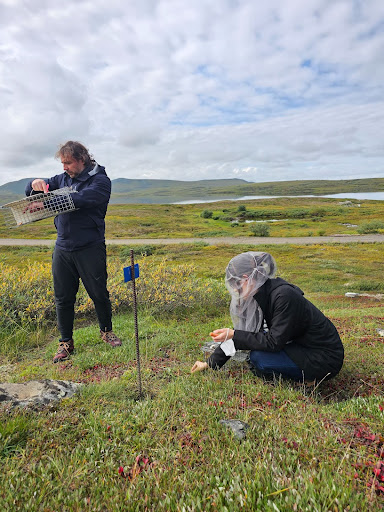Hibernation science workshop draws participants from around the globe
Recently the Center for Transformative Research in Metabolism, part of the Institute of Arctic Biology, hosted its first large-scale workshop in hibernation science.
The two-week event drew on expertise from University of Alaska Fairbanks faculty as well as invited lecturers and included discussions of novel research in hibernating mammals such as the black bear and the iconic Arctic ground squirrel. The two-week workshop culminated with a visit to Toolik Field Station where these small and charismatic mammals are abundant.

Domenic Tupone (L), who holds dual appointments as an Assistant Professor at Oregon Health and Science University’s Department of Neurological Surgery and the Dipartimento di Scienze Biomediche e Neuromotorie at the University of Bologna, and Ching Pu Chang (R) from The Exploratory Research Center on Life and Living Systems, National Institutes of Natural Sciences in Japan practice setting traps for Arctic ground squirrels at Toolik Field Station.
Professor Brian Barnes pioneered hibernation science in the late 80s when he discovered that Arctic ground squirrels lower their body temperature to 27 degrees Fahrenheit or -3 degrees Celsius to survive the harsh winters of the Arctic. Barnes co-hosted the two-week workshop with UAF faculty Professor Kelly Drew, who studies the pharmacological effects of hibernation science and Research Assistant Professor Øivind Tøien who studies hibernation in bears.
“We were so pleased with the quality of participants in this first workshop on hibernation science, which included scientists from Japan, Italy, China, the NIH, and several U.S. universities,” said Barnes. “Our major goal is to introduce the next generation of researchers to unsolved questions about mammalian hibernation and the potential for developing spin-offs to improve human health.”
Most participants had no experience before the workshop with investigating hibernation in wild species like the Arctic ground squirrel. The event provided opportunities to see the squirrels in the lab and also in the field at IAB’s Toolik Field Station located in the northern foothills of the Brooks Range.
For Iñigo Yoldi Bergua, a graduate student intern from Montpellier, France who works in Kelly Drew’s lab and studies the muscle preservation and neuroprotective properties of hibernating animals, the workshop provided a wider lens to view the research areas of hibernation science.
“What was great about the workshop is that we were able to learn many different aspects about the field,” said Yoldi Bergua. ”Sometimes when you are doing your own research it’s easy to get too focused on your own questions.”
Yoldi Bergua also valued the ability to observe animal behavior outside of the lab.
“If you study an animal model you have to see it in the wild. You have to witness its behavior,” he said. “Arctic ground squirrels exist in a remote area and we had a unique opportunity with this workshop to travel to their environment at Toolik Lake.”
For others who were not already familiar with hibernation science, the crash course in mammalian hibernation and supercooling was eye-opening.
“It’s been a great learning experience,” said Neeraj Lal, a postdoctoral student at Scripps Research in San Diego. “The workshop has been an inflection point in my career. I thought about hibernation science earlier, but didn’t think to pursue it as a research focus. Now looking at all the advances I’ve seen in the workshop and the fascinating biology of the animals, I think a major portion of my future research will deal with learning about the biology of hibernators and the potential applications we can learn from them for humans.”

Participants from the Hibernation Science Workshop stop at the Yukon River on the way to Toolik Field Station.
Great strides have been made in the field of hibernation science since the 80s and the potential for applications in human physiology runs the gamut from allowing long-distance space travel to halting brain damage in stroke victims.
“The potential is so great for myriad, lifesaving applications of hibernation science in humans,” said Drew, who is a neuropharmacologist. “We’ve only just scratched the surface with the research we’ve conducted so far. This workshop was a way to bring students and faculty together to learn from one another and map out some possible next steps.”


